
文件所有权
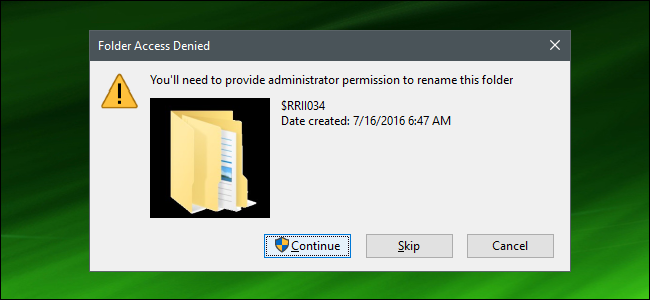
If you’ve ever been denied access to a file or folder in Windows, chances are you need to take ownership of them with your user account. Here’s how.
如果您曾经被拒绝访问Windows中的文件或文件夹,则可能需要使用您的用户帐户来拥有它们的所有权。 这是如何做。
- Right-click the object and choose “Properties.” 右键单击该对象,然后选择“属性”。
- In the Properties window, on the “Security” tab, click “Advanced.” 在“属性”窗口中的“安全性”选项卡上,单击“高级”。
- Next to the listed Owner, click the “Change” link. 在列出的所有者旁边,单击“更改”链接。
- Type your user account name into the “Enter the object name to select” box and then click “Check Names.” 在“输入要选择的对象名称”框中键入您的用户帐户名称,然后单击“检查名称”。
- When the name is validated, click “OK.” 验证名称后,单击“确定”。
- Click “OK” twice more to exit out of the properties windows. 再单击两次“确定”退出属性窗口。
In Windows, a user that has ownership of a file or folder has implicit rights to change permissions on that object. That user is also always allowed to access the file or folder—even when other permissions seemingly contradict that access. When you create a file or folder, the user account under which you’re logged in automatically gets ownership.
在Windows中,拥有文件或文件夹所有权的用户具有更改该对象权限的隐式权限。 始终允许该用户访问文件或文件夹,即使其他权限似乎与该访问相抵触也是如此。 创建文件或文件夹时,用于登录的用户帐户将自动获得所有权。
But you might occasionally run into a situation where you need to take ownership of a file or folder. Maybe you’ve got files or folders that were created by a user account that has since been deleted. Maybe you’ve got a hard drive from another PC that you’re working on. Or maybe you just need access to a particular system file—like “notepad.exe”— so you can apply a hack. Whatever your reason, here’s the official way to take ownership of a file or folder. And once you’ve learned how to do it, why not make it even easier and add a “Take Ownership” command right to your context menu?
但是您有时可能会遇到需要获取文件或文件夹所有权的情况。 也许您有一个由用户帐户创建的文件或文件夹,此文件或文件夹已被删除。 也许您正在使用另一台PC上的硬盘驱动器。 或者,也许您只需要访问特定的系统文件( 例如“ notepad.exe” ),即可进行黑客攻击。 无论出于何种原因,这都是获取文件或文件夹所有权的官方方法。 而且,一旦您学会了如何做,为什么不使它变得更加简单,并在上下文菜单中添加“获取所有权”命令呢?
First, make sure you’re logged on with an account that has administrative privileges. By default, any administrative account can take ownership of a file or folder in Windows.
首先,请确保您使用具有管理特权的帐户登录。 默认情况下,任何管理帐户都可以拥有Windows中文件或文件夹的所有权。
Right-click the file or folder and choose “Properties” from the context menu.
右键单击文件或文件夹,然后从上下文菜单中选择“属性”。
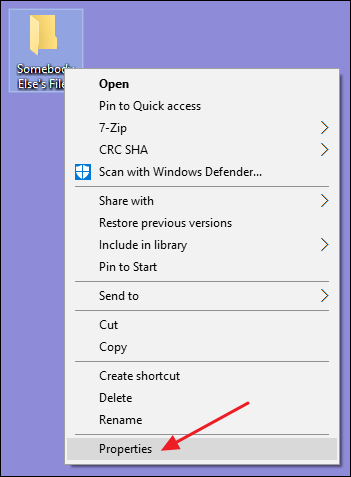
In the Properties window, switch to the “Security” tab, and then click the “Advanced” button.
在“属性”窗口中,切换到“安全性”选项卡,然后单击“高级”按钮。
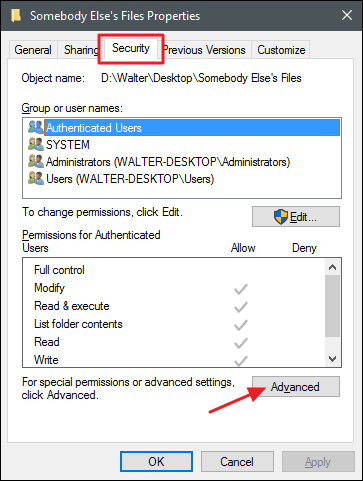
In Windows 8 or 10, in the “Advanced Security Settings” window, click the “Change” link next to the listed owner.
在Windows 8或10中,在“高级安全设置”窗口中,单击列出的所有者旁边的“更改”链接。
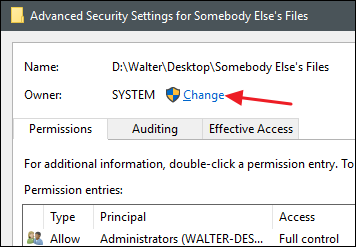
In Windows 7, the “Advanced Security Settings” window has a separate “Owner” tab where you’ll make these changes. On that tab, click the “Edit” button and then click the “Other Users or Groups” button on the subsequent page.
在Windows 7中,“高级安全设置”窗口具有单独的“所有者”选项卡,您可以在其中进行这些更改。 在该选项卡上,单击“编辑”按钮,然后在下一页上单击“其他用户或组”按钮。
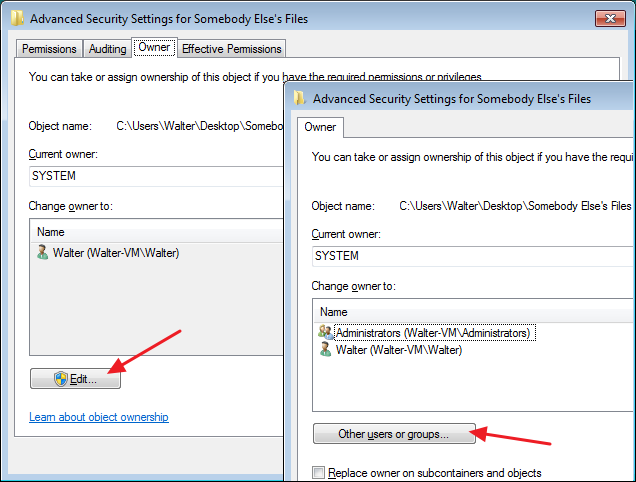
From that point, the rest of the instructions in this article apply whether you’re using Windows 7, 8, or 10.
从那时起,无论您使用的是Windows 7、8还是10,本文中的其余说明均适用。
In the “Select User or Group” window, in the “Enter the object name to select” box, type your user account name, and then click the “Check Names” button. If you typed a valid name, the name should change to show the full user name path with the PC name before it. You can then click the “OK” button.
在“选择用户或组”窗口中的“输入要选择的对象名称”框中,键入您的用户帐户名称,然后单击“检查名称”按钮。 如果键入了有效的名称,则名称应更改为显示完整的用户名路径,并在其前显示PC名称。 然后,您可以单击“确定”按钮。

NOTE: If you’re using a Microsoft account (rather than a local account), your official user name is just the first 5 letters of the full email address you used to set up the account. You’ve probably also noticed that those five letters were also used to name your user folder.
注意:如果您使用的是Microsoft帐户 (而不是本地帐户),那么您的正式用户名就是您用来设置该帐户的完整电子邮件地址的前5个字母。 您可能还注意到,这五个字母也用于命名用户文件夹。
Back in the “Advanced Security Settings” window, you’ll see that your user account is now listed as the owner of the object. If it’s a folder, you’ll also see an option under the owner named “Replace owner on subcontainers and objects.” Make sure that’s selected and then click “OK.”
返回“高级安全设置”窗口,您将看到您的用户帐户现在被列为对象的所有者。 如果是文件夹,您还将在名为“替换子容器和对象的所有者”的所有者下看到一个选项。 确保已选中,然后单击“确定”。

And back on the “Security” tab of the file’s Properties window, click the “OK” button.
然后返回文件“属性”窗口的“安全性”选项卡,单击“确定”按钮。
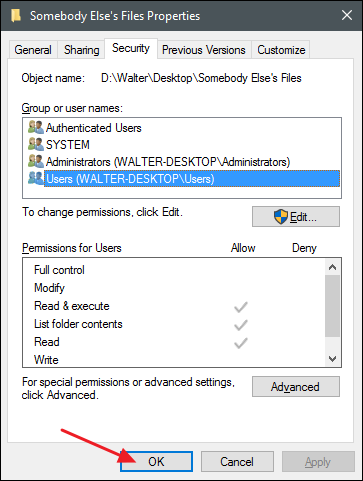
You should now have full ownership of and access to your file or folder.
现在,您应该拥有文件或文件夹的完全所有权并可以对其进行访问。
翻译自: https://www.howtogeek.com/301768/how-to-take-ownership-of-files-and-folders-in-windows/
文件所有权





















 288
288











 被折叠的 条评论
为什么被折叠?
被折叠的 条评论
为什么被折叠?








